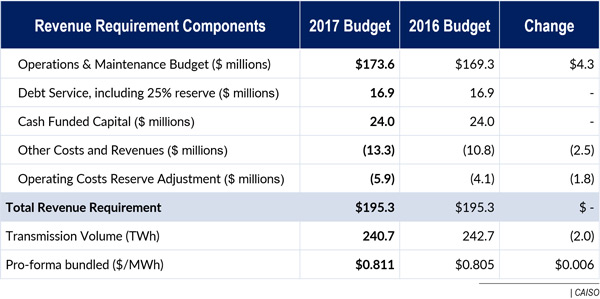By Robert Mullin
CAISO’s Board of Governors approved a 2017 budget that includes a $4.3 million increase in spending but no corresponding rise in the grid operator’s revenue requirement.
“I do think it’s worth pointing out that the board has been engaged in development and review” of the budget before the vote, CAISO CEO Steve Berberich said during the board’s Dec. 15 meeting. “So it’s really been an ongoing process. This is just the final step.”
Although the ISO’s total expenditures are set to increase by 2% to $214.5 million, the annual revenue requirement will remain unchanged at $195.3 million, 18% its 2003 peak and 3.5% under the current FERC-approved cap.
The reason: Next year’s $4.6 million rise in labor expenses will be offset by expected revenues from other sources, including money earned from administering the Western Energy Imbalance Market (EIM). The EIM is projected to bring in $4.8 million for the ISO in 2017, compared with $2.5 million this year.
The ISO’s revenue requirement consists of five components, including operations and maintenance, debt service, cash-funded capital, an operation cost adjustment from the previous year and other costs and revenues. Those additional revenues are collected through EIM administrative charges and fees assessed for intermittent resource forecasting and generator interconnections.
CAISO recovers its revenue requirement through grid management charges assessed to market participants based on their use of the transmission system to serve load or deliver exports. The charges are slated to increase slightly next year, with ISO transmission volumes projected to fall 2 TWh, to 240.7 TWh. The drop continues a decline in recent years that’s due in part to a persistent drought, which has reduced the volume of water being moved across the state using a massive network of electrical pumps.
Fixed fees related to market operations — such as inter-scheduling coordinator trade and congestion revenue rights fees — will remain unchanged.
Operations and maintenance constitutes about 80% of the ISO’s budget at $173.6 million, up 2.6% because of rising labor costs, including merit pay and benefit increases for existing staff and the addition of seven new employees.
CFO Ryan Seghesio earlier this year told stakeholders that CAISO has held a “tough line” on headcount but that “stress points” in several departments necessitated additional hiring. (See CAISO Sees Steady Revenue Requirement Despite Spending Rise.)
The increased labor expenses will be partially offset by decreased costs from vacating the ISO’s Alhambra leased site, as well as declining outlays for consulting and contract staff.
Debt service costs will hold steady at $16.9 million. Construction of the ISO’s headquarters accounts for most of the debt, according to April Gordon, the ISO’s manager for budgeting and planning. Debt costs remain well below the 2006 peak of more than $80 million.
CAISO estimates it will spend $20 million on capital projects next year, most of them related to technology upgrades to support existing and new market operations.
Any minor year-end adjustments to the O&M budget made after the board’s approval will not affect the final approved budget, the ISO said.




